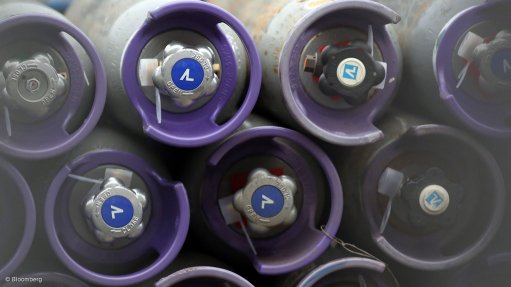South African space agency had key role in latest US moon probe mission
The Space Operations division of the South African National Space Agency (Sansa) recently released details of its involvement in the US National Aeronautics and Space Administration’s (Nasa’s) Lunar Atmosphere and Dust Environment Explorer (Ladee, pronounced Laddie) mission, which has been successfully concluded. The Ladee mission was launched in September 2013, started orbiting the moon at an altitude of 250 km on October 6 and concluded with the space probe making a planned impact on the lunar surface on April 17.
“We have been supporting this mission since the date of launch,” reported Sansa Space Operations International Business Manager Tiaan Strydom. “Our team played an important role in providing various TT&C – telemetry, tracking and control – support services to the probe since launch in September 2013, with this coming to an end as the final manoeuvres were executed together with other ground stations, tasking the probe to deorbit.”
The deorbiting proceedure put Ladee on a course to crash into the surface of the far side of the moon. According to Nasa, the probe would have been travelling at 3 600 mph (about 5 380 km/h) when it impacted. The US agency hopes, in due course, to image the crash site from another of its space probes, the Lunar Reconnaissance Orbiter, which was launched in June 2009.
Ladee’s primary mission was to collect detailed data on the moon’s very tenuous atmosphere, including its density and composition, as well as any temporal and/or spatial variation in that atmosphere. It also studied conditions near the lunar surface and environmental influences on moon dust. It started gathering data in November, when its orbital altitude had been reduced to between 20 km and 60 km. (This altitude variation was due to the moon’s uneven gravitational field.)
Ladee was also Nasa’s first spacecraft equipped to carry out two-way communications using laser beams instead of radio waves. This experiment, the Lunar Laser Communication Demonstration, used a pulsed laser to download data at a rate of 622 megabits per second (Mbps) over a range of more than 384 000 km. In return, the primary ground station in the US state of New Mexico was able to achieve an error-free upload rate of 20 Mbps to Ladee’s laser communications space terminal.
Apart from the laser communi- cations demonstrator, the probe carried three experiments. The Ultraviolet and Visible Light Spectrometer functioned to establish the composition of the moon’s atmosphere by analysing the light signatures of the materials in that atmosphere. The Neutral Mass Spectrometer measured variations in the lunar atmosphere, over many orbits and with the Moon in varying space environments. The lunar dust experiment collected and analysed samples of any dust it found in the extremely thin lunar atmosphere.
Decades ago, Apollo astronauts on the moon reported seeing a presunrise glow. Ladee confirmed the existence of this glow, which appears to be zodiacal light – sunlight scattered by innumerable dust grains, probably from comets, in the innermost part of the solar system. However, the previous hypothesis about the moon’s predawn glow – that it could be caused by lunar dust that had been electrically charged by sunlight – will now be refuted or reinforced by the analysis of the data from the lunar dust experiment.
On the conclusion of its 100-day primary science phase in March, the Ladee mission was extended. Thereafter, lacking the fuel to achieve a stable lunar orbit, the probe was deorbited, which had the benefit of allowing it to gather data from ever-lower altitudes, until it disappeared behind the moon for the last time. Scientific analysis of the data from Ladee will continue for months.
“We would like to consider our- selves as the leading ground station on the continent,” stated Sansa Space Operations MD Raoul Hodges. “Being part of such cutting edge research and services proves that no mission is too big or too small for our capabilities.”
Comments
Press Office
Announcements
What's On
Subscribe to improve your user experience...
Option 1 (equivalent of R125 a month):
Receive a weekly copy of Creamer Media's Engineering News & Mining Weekly magazine
(print copy for those in South Africa and e-magazine for those outside of South Africa)
Receive daily email newsletters
Access to full search results
Access archive of magazine back copies
Access to Projects in Progress
Access to ONE Research Report of your choice in PDF format
Option 2 (equivalent of R375 a month):
All benefits from Option 1
PLUS
Access to Creamer Media's Research Channel Africa for ALL Research Reports, in PDF format, on various industrial and mining sectors
including Electricity; Water; Energy Transition; Hydrogen; Roads, Rail and Ports; Coal; Gold; Platinum; Battery Metals; etc.
Already a subscriber?
Forgotten your password?
Receive weekly copy of Creamer Media's Engineering News & Mining Weekly magazine (print copy for those in South Africa and e-magazine for those outside of South Africa)
➕
Recieve daily email newsletters
➕
Access to full search results
➕
Access archive of magazine back copies
➕
Access to Projects in Progress
➕
Access to ONE Research Report of your choice in PDF format
RESEARCH CHANNEL AFRICA
R4500 (equivalent of R375 a month)
SUBSCRIBEAll benefits from Option 1
➕
Access to Creamer Media's Research Channel Africa for ALL Research Reports on various industrial and mining sectors, in PDF format, including on:
Electricity
➕
Water
➕
Energy Transition
➕
Hydrogen
➕
Roads, Rail and Ports
➕
Coal
➕
Gold
➕
Platinum
➕
Battery Metals
➕
etc.
Receive all benefits from Option 1 or Option 2 delivered to numerous people at your company
➕
Multiple User names and Passwords for simultaneous log-ins
➕
Intranet integration access to all in your organisation


















